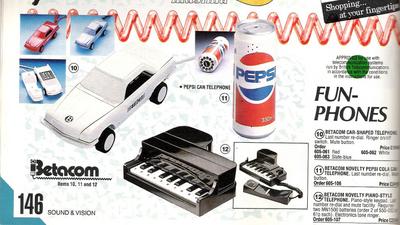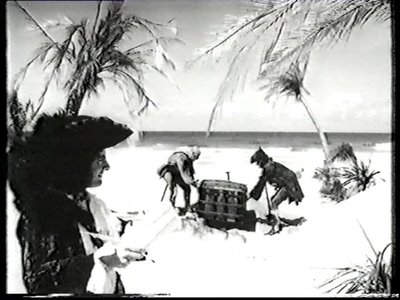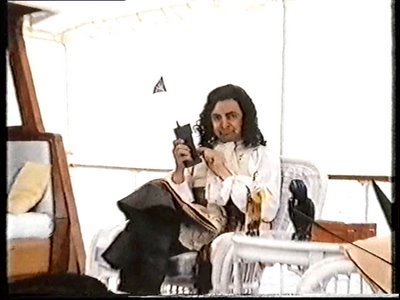 Spoof magazine interview found in a pub in December 1989...
Spoof magazine interview found in a pub in December 1989...3 October 1988 was a grand day in the history of television. Nope, it wasn't the launch of Channel 4, breakfast TV, or Sky TV - those events occurred in 1982, 1983 and 1989 respectively.
No, think, mateyboots, think...
Can't think?
Oh well - 1988 gave us THIS MORNING with husband and wife presenters Richard Madeley and Judy Finnigan, and it really was quite something. The 1980s saw UK television going all day and all night, something for everybody, but for years into the decade the mornings were so drop dead boring you could have wept. Picture it, you take a sickie, you're at home, luxuriating with an economy sized Wispa, and all you have to watch is schools programmes! I mean - PURLEASE!!!
All right, if you were lucky, you could slam in a video, but as we've already seen elsewhere on this site, the spread of VCRs was slow, so you probably didn't have the option.
Morning TV had been looking a little more hopeful since the launch of the BBC's daytime service in October 1986, but then, suddenly - BAM!! - the ITV schools programmes were accommodated on Channel 4 in 1987, and we got This Morning the following year, an all-sorts mix of human and celebrity stories, fashion, cookery, health - you name it!
The show was revolutionary - before that we'd had to wait until nearly lunchtime for even a glimmer of anything interesting, unless you counted the 10am repeat of yesterday's Neighbours.
And This Morning was also revolutionary in length. In the first instalment, Richard and Judy informed the audience that they were going to be on air for the next two hours!
This Morning was broadcast by Granada TV, live from the Albert Dock in Liverpool.
I liked it a lot... although maybe it seemed a little middle class, it wasn't as stuffy (or middle class) as some previous magazine-style shows, and I grew fond of Richard and Judy, cook Susan Brookes, weatherman Fred Talbot, agony aunt Denise Robertson, etc, etc, etc.
Richard and Judy, who had met back in the year of the Falklands and the deelyboppers - 1982 - soon became the darlings of daytime TV, so much so that many of us referred to the show as Richard & Judy.
By late 1989, This Morning was an institution.
And it was in December 1989, sitting, jaded after too much festive cheer, in a bar in Islington, that I found an alternative magazine staring up at me from the bar, and took a look.
And it contained a delicious spoof article on This Morning that made me chuckle. And still makes me chuckle to this day. It's a brilliant piece of tongue-in-cheek, razor sharp late 1980s humour, it struck a chord with me, and with apologies to Richard, Judy, and anybody else involved with This Morning back then, I reproduce it below.
And remember this is a SPOOF interview - Richard and Judy had nothing to do with it! Bless 'em!
GOOD MORNING
BREAKFAST TELEVISION
with RICHARD & JUDY
If you are a man between the ages of 20 and 70, or a woman between 18 and 35, you could be a morning television presenter.
JUDY: Believe me, it is hard work - introducing reports on knitting patterns, getting bread to rise properly, coffeetime interviews and soap debates.
RICHARD: But also true stories of love, humanity and courage that bring people closer together.
JUDY: That's right. It's taking the events of the day and presenting them nicely. It's knowing what to say when there is nothing to say, and wearing something nice.
RICHARD: No one ever said it would be easy.
JUDY: (LAUGHS) But seriously. The hard work has its advantages - your face is instantly recognisable, people let you go ahead of them in queues, and old men send you gifts in the mail. You and your public share a genuine warmth that is all too rare these days. I suppose more than anything, if you're a woman, is not to wiggle and pout when they point the camera at you.
RICHARD: That's right.
WHAT IS AN ITEM?
JUDY: It can be almost anything. Would you make some coffee, Richard? (RICHARD GETS UP AND MAKES EVERYONE COFFEE) An item can be almost anything! Like if a viewer suffers food poisoning from a poor quality tin of smoked salmon, that's news. If Margaret Thatcher gets a new hairstyle, that's news. If a soap star gets a divorce, that's news as well. The public has a right to know. Isn't that right, Richard?
RICHARD: Absolutely, Judy.
WHERE DO ITEMS COME FROM?
RICHARD: Most of the items come from the teletype machine...
JUDY: ... which is a neat black printing machine on our desk.
YOU BOTH USED TO BE REPORTERS, SO WHAT IS JOURNALISM?
RICHARD: Oh, errrr...
JUDY: We'll be right back after this break.
DO YOU GET TO TRAVEL?
JUDY: I sometimes do reports.... like recently I visited a school for the severely brain damaged diabetic children and we made a film. At first I was so worried that it wouldn't come out right, but they all proved to be really photogenic.
RICHARD: And it looked really good. (PAUSE) And we just thank god the 'twins' are healthy and normal.
TELL US ABOUT 'WARMTH'
JUDY: Undoubtedly the key to warmth is not to think about what you're reading from your autocue. I always imagine my viewers. I picture them writing one of those wonderful letters and I see their bright smiling faces.
RICHARD: I never knew that, Judy.
JUDY: (GLARES AT RICHARD) An information booklet accompanies this series...
WHAT ABOUT AD-LIB?
RICHARD: (LAUGHS) Well, this is when the autocue is not working...
JUDY: Or has been turned off. (BOTH LAUGH)
RICHARD: It is, of course, the most challenging time for a presenter.
JUDY: Like the other day, there was this story about handicapped children participating in their first annual wheelchair marathon, and the autocue suddenly stopped working, so I said "If you spend time with the handicapped...
RICHARD: That's right, (CONTINUING FOR JUDY) 'I think, well, their hopes and dreams become part of you.'
JUDY: (LONG PAUSE. DEEP BREATH. RUBS FINGERS ON THE BRIDGE OF HER NOSE) Let's take a short commercial break, but we'll be back with the sort of hair you'll be wearing next year.
TELL US ABOUT THE WEATHER
RICHARD: Fortunately, we don't have to do the weather.
JUDY: But we do have to talk with the Weather Personality. Always keep an eye on him.
RICHARD: Yes, if he loses weight or his skin clears up - he could be your next replacement.
JUDY: And remember that the weather personality makes the final impact on your public, so if he talks bad weather, interrupt him - "Rain, rain, rain. Don't you have anything good for us?"
RICHARD: Or, "Surely it's going to improve for the weekend?"
JUDY: But you've got to get the timing right - make sure the closing signature tune leaves him no time to say anything clever.






























































